Lawsonia Inermis Markedly Improves Cognitive Functions in Animal Models and Modulate Oxidative Stress Markers in the Brain
Abstract
1. Introduction
2. Materials and Methods
2.1. Drugs and Chemicals
2.2. Plant Collection
Extract Preparation
2.3. Gas Chromatography-Mass Spectroscopy (GC-MS) Analysis
2.4. Experimental Animals
2.4.1. Acute Toxicity
2.4.2. Study Design
2.4.3. Estimation of Memory-Enhancing Activity without Induction of Amnesia
2.4.4. Estimation of Memory-Enhancing Activity in Diazepam-Induced Amnesia Model
2.5. Models for Behavioral Studies
2.5.1. Elevated plus Maze (EPM) Task
2.5.2. Training and Test Sessions
2.6. Passive Shock Avoidance Paradigm
Training and Test Sessions
2.7. Assessment of Biological Indicators of Oxidative Stress
2.7.1. Brain Tissue Preparation
2.7.2. Estimation of Glutathione
2.7.3. Estimation of Superoxide Dismutase (SOD)
2.7.4. Estimation of Catalase (CAT)
2.8. In Vitro 2,2-diphenyl-1-picrylhydrazyl (DPPH) Free Radical Scavenging Assay
2.9. Statistical Analysis
3. Results
3.1. GC-MS Analysis of L. Inermis
3.2. Acute Toxicity
3.3. Effect of Lawsonia Inermis Ethanol (Li.Et) and Lawsonia Inermis Chloroform (Li.Chf) on Transfer Latency Using EPM Paradigm
3.4. Effect of Li.Et and Li.Chf on Step-Down Latency Using Passive Avoidance Paradigm
3.5. Assessment of Biological Indicators of Oxidative Stress
3.5.1. Estimation of Glutathione (GSH)
3.5.2. Estimation of SOD
3.5.3. Estimation of CAT
3.6. DPPH Free Radicals Scavenging Activity
4. Discussion
5. Conclusions
Supplementary Materials
Author Contributions
Funding
Acknowledgments
Conflicts of Interest
References
- Mayeux, R. Early Alzheimer’s disease. N. Eng. J. Med. 2010, 362, 2194–2201. [Google Scholar] [CrossRef]
- Bachurin, S.O.; Bovina, E.V.; Ustyugov, A.A. Drugs in clinical trials for Alzheimer’s disease: The major trends. Med. Res. Rev. 2017, 37, 1186–1225. [Google Scholar] [CrossRef] [PubMed]
- Ovais, M.; Zia, N.; Ahmad, I.; Khalil, A.T.; Raza, A.; Ayaz, M.; Sadiq, A.; Ullah, F.; Shinwari, Z.K. Phyto-therapeutic and nanomedicinal approach to cure Alzheimer disease: Present status and future opportunities. Front. Aging Neurosci. 2018, 10, 284. [Google Scholar] [CrossRef]
- Kumar, A.; Singh, A. A review on Alzheimer’s disease pathophysiology and its management: An update. Pharmacol. Rep. 2015, 67, 195–203. [Google Scholar] [CrossRef] [PubMed]
- Rice-Evans, C.A.; Miller, N.J.; Paganga, G. Structure-antioxidant activity relationships of flavonoids and phenolic acids. Free Radic. Biol. Med. 1996, 20, 933–956. [Google Scholar] [CrossRef]
- Sadiq, A.; Zeb, A.; Ullah, F.; Ahmad, S.; Ayaz, M.; Rashid, U.; Muhammad, N. Chemical characterization, analgesic, antioxidant, and anticholinesterase potentials of essential oils from Isodon rugosus Wall. ex. Benth. Front. Pharmacol. 2018, 9, 623. [Google Scholar] [CrossRef]
- Ayaz, M.; Junaid, M.; Ullah, F.; Sadiq, A.; Khan, M.A.; Ahmad, W.; Shah, M.R.; Imran, M.; Ahmad, S. Comparative chemical profiling, cholinesterase inhibitions and anti-radicals properties of essential oils from Polygonum hydropiper L.: A preliminary anti-Alzheimer’s study. Lipids Health Dis. 2015, 14, 141. [Google Scholar] [CrossRef]
- Devasagayam, T.; Tilak, J.; Boloor, K.; Sane, K.S.; Ghaskadbi, S.S.; Lele, R. Free radicals and antioxidants in human health: Current status and future prospects. J. Assoc. Physicians India 2004, 52, 794–804. [Google Scholar]
- Summers, W.K.; Martin, R.L.; Cunningham, M.; DeBoynton, V.L.; Marsh, G.M. Complex antioxidant blend improves memory in community-dwelling seniors. J. Alzheimer’s Dis. 2010, 19, 429–439. [Google Scholar] [CrossRef] [PubMed]
- Frank, B.; Gupta, S. A review of antioxidants and Alzheimer’s disease. Ann. Clin. Psychiatry 2005, 17, 269–286. [Google Scholar] [CrossRef] [PubMed]
- Danta, C.C.; Piplani, P. The discovery and development of new potential antioxidant agents for the treatment of neurodegenerative diseases. Expert Opin. Drug Discov. 2014, 9, 1205–1222. [Google Scholar] [CrossRef] [PubMed]
- De Kloet, E.R.; Joëls, M.; Holsboer, F. Stress and the brain: From adaptation to disease. Nature Rev. Neurosci. 2005, 6, 463. [Google Scholar] [CrossRef] [PubMed]
- Ovais, M.; Khalil, A.T.; Raza, A.; Islam, N.U.; Ayaz, M.; Saravanan, M.; Ali, M.; Ahmad, I.; Shahid, M.; Shinwari, Z.K. Multifunctional theranostic applications of biocompatible green-synthesized colloidal nanoparticles. Appl. Microbial. Biotechnol. 2018, 102, 4393–4408. [Google Scholar] [CrossRef]
- Yuen, E.Y.; Liu, W.; Karatsoreos, I.N.; Feng, J.; McEwen, B.S.; Yan, Z. Acute stress enhances glutamatergic transmission in prefrontal cortex and facilitates working memory. Proc. Natl. Acad. Sci. USA 2009, 106, 14075–14079. [Google Scholar] [CrossRef] [PubMed]
- Esch, T.; Stefano, G.B.; Fricchione, G.L.; Benson, H. The role of stress in neurodegenerative diseases and mental disorders. Neuro Endocrinol. Lett. 2002, 23, 199–208. [Google Scholar] [PubMed]
- Ayaz, M.; Junaid, M.; Ullah, F.; Subhan, F.; Sadiq, A.; Ali, G.; Ovais, M.; Shahid, M.; Ahmad, A.; Wadood, A. Anti-Alzheimer’s studies on β-sitosterol isolated from Polygonum hydropiper L. Front. Pharmacol. 2017, 8, 697. [Google Scholar] [CrossRef] [PubMed]
- Linden, D.; Martinez, J.L. Leu-enkephalin impairs memory of an appetitive maze response in mice. Behav. Neurosci. 1986, 100, 33. [Google Scholar] [CrossRef] [PubMed]
- Ader, R.; de Wied, D. Effects of lysine vasopressin on passive avoidance learning. Psychon. Sci. 1972, 29, 46–48. [Google Scholar] [CrossRef]
- Lynch, M. Long-term potentiation and memory. Physiol. Rev. 2004, 84, 87–136. [Google Scholar] [CrossRef]
- Cragg, G.M.; Newman, D.J.; Snader, K.M. Natural products in drug discovery and development. J. Nat. Prod. 1997, 60, 52–60. [Google Scholar] [CrossRef]
- Atanasov, A.G.; Waltenberger, B.; Pferschy-Wenzig, E.-M.; Linder, T.; Wawrosch, C.; Uhrin, P.; Temml, V.; Wang, L.; Schwaiger, S.; Heiss, E.H. Discovery and resupply of pharmacologically active plant-derived natural products: A review. Biotechnol. Adv. 2015, 33, 1582–1614. [Google Scholar] [CrossRef] [PubMed]
- Ayaz, M.; Sadiq, A.; Junaid, M.; Ullah, F.; Subhan, F.; Ahmed, J. Neuroprotective and anti-aging potentials of essential oils from aromatic and medicinal plants. Front. Aging Neurosci. 2017, 9, 168. [Google Scholar] [CrossRef] [PubMed]
- Ovais, M.; Khalil, A.T.; Islam, N.U.; Ahmad, I.; Ayaz, M.; Saravanan, M.; Shinwari, Z.K.; Mukherjee, S. Role of plant phytochemicals and microbial enzymes in biosynthesis of metallic nanoparticles. Appl. Microbial. Biotechnol. 2018, 102, 6799–6814. [Google Scholar] [CrossRef]
- Ayaz, M.; Sadiq, A.; Wadood, A.; Junaid, M.; Ullah, F.; Khan, N.Z. Cytotoxicity and molecular docking studies on phytosterols isolated from Polygonum hydropiper L. Steroids 2019, 141, 30–35. [Google Scholar] [CrossRef]
- Ayaz, M.; Subhan, F.; Sadiq, A.; Ullah, F.; Ahmed, J.; Sewell, R. Cellular efflux transporters and the potential role of natural products in combating efflux mediated drug resistance. Front. Biosci. 2017, 22, 732–756. [Google Scholar] [CrossRef]
- Boubaya, A.; Hannachi, H.; Marzougui, N.; Triki, T.; Guasmi, F.; Ferchichi, A. Genetic diversity assessment of Lawsonia inermis germplasm in Tunisian coastal oases by ISSR and RAPD markers. Dendrobiology 2013, 69. [Google Scholar] [CrossRef]
- Bonjar, S. Evaluation of antibacterial properties of some medicinal plants used in Iran. J. Ethnopharmacol. 2004, 94, 301–305. [Google Scholar] [CrossRef] [PubMed]
- Al-Omar, M.A. Dye of henna, on aldehyde oxidase activity in guinea pig liver. J. Med. Sci. 2005, 5, 163–168. [Google Scholar]
- Bhandarkar, M.; Khan, A. Protective effect of Lawsonia alba lam., against CCI4 induced hepatic damage in albino rats. Indian J. Exp. Biol. 2003, 41, 85. [Google Scholar]
- Khan, M.A.A.; Jain, D.; Bhakuni, R.; Zaim, M.; Thakur, R. Occurrence of some antiviral sterols in Artemisia annua. Plant Sci. 1991, 75, 161–165. [Google Scholar] [CrossRef]
- Singh, V.; Pandey, D. Fungitoxic studies on bark extract of Lawsonia inermis against ringworm fungi. Hindustan Antibiot. Bull. 1988, 31, 32–35. [Google Scholar]
- Shiksharthi, A.; Mittal, S.; Ramana, J. Systematic review of herbals as potential memory enhancers. Int. J. Res. Pharm. Biomed. Sci. 2011, 3, 918–925. [Google Scholar]
- Aggarwal, B.B.; Sundaram, C.; Malani, N.; Ichikawa, H. Curcumin: The Indian solid gold. In The Molecular Targets and Therapeutic Uses of Curcumin in Health and Disease; Springer: Berlin, Germany, 2007; pp. 1–75. [Google Scholar]
- Shah, S.M.; Ullah, F.; Ayaz, M.; Sadiq, A.; Hussain, S.; Shah, A.; Shah, S.A.A.; Ullah, N.; Ullah, F.; Ullah, I. Benzoic acid derivatives of Ifloga spicata (Forssk.) Sch.Bip. as potential anti-Leishmanial against Leishmania tropica. Processes 2019, 7, 208. [Google Scholar] [CrossRef]
- Ayaz, M.; Junaid, M.; Ullah, F.; Sadiq, A.; Shahid, M.; Ahmad, W.; Ullah, I.; Ahmad, A.; Syed, N.-i.-H. GC-MS analysis and gastroprotective evaluations of crude extracts, isolated saponins, and essential oil from Polygonum hydropiper L. Front. Chem. 2017, 5, 58. [Google Scholar] [CrossRef]
- Garber, J.; Barbee, R.; Bielitzki, J.; Clayton, L.; Hendriksen, C.; Donovan, J. Guide for the Care and Use of Laboratory Animals; The National Academic Press: Washington, DC, USA, 2010. [Google Scholar]
- OECD. Acute oral toxicity—Fixed dose procedure. In OECD Guidelines for Testing of Chemicals; OECD: Paris, France, 2001. [Google Scholar]
- Vasudevan, M.; Parle, M. Memory enhancing activity of Anwala Churna (Emblica officinalis Gaertn.): An ayurvedic preparation. Physiol. Behav. 2007, 91, 46–54. [Google Scholar] [CrossRef]
- Parle, M.; Dhingra, D.; Kulkarni, S. Improvement of mouse memory by Myristica fragrans seeds. J. Med. Food 2004, 7, 157–161. [Google Scholar] [CrossRef]
- Joshi, H.; Parle, M. Zingiber officinale: Evaulation of its nootropic effect in mice. AJTCAM 2006, 3, 64–74. [Google Scholar] [CrossRef]
- Parle, M.; Dhingra, D. Ascorbic acid: A promising memory-enhancer in mice. J. Pharmacol. Sci. 2003, 93, 129–135. [Google Scholar] [CrossRef]
- Kumar, M.V.; Gupta, Y. Effect of different extracts of Centella asiatica on cognition and markers of oxidative stress in rats. J. Ethnopharmacol. 2002, 79, 253–260. [Google Scholar] [CrossRef]
- Anwar, F.; Hira, S.; Ahmad, B.; Saleem, U. Antioxidants attenuate isolation- and L-DOPA-induced aggression in mice. Front. Pharmacol. 2017, 8, 945. [Google Scholar]
- Bhangale, J.O.; Acharya, S.R. Anti-Parkinson activity of petroleum ether extract of Ficus religiosa (L.) leaves. Adv. Pharmacol. Sci. 2016, 2016, 9436106. [Google Scholar] [PubMed]
- Kath, R.; Gupta, R. Antioxidant activity of hydroalcoholic leaf extract of Ocimum sanctum in animal models of peptic ulcer. Indian J. Physiol. Pharmacol. 2006, 50, 391. [Google Scholar]
- Zohra, T.; Ovais, M.; Khalil, A.T.; Qasim, M.; Ayaz, M.; Shinwari, Z.K. Extraction optimization, total phenolic, flavonoid contents, HPLC-DAD analysis and diverse pharmacological evaluations of Dysphania ambrosioides (L.) mosyakin & clemants. Nat. Prod. Res. 2019, 33, 136–142. [Google Scholar] [PubMed]
- Weissgerber, T.L.; Garcia-Valencia, O.; Garovic, V.D.; Milic, N.M.; Winham, S.J. Meta-research: Why we need to report more than ’data were analyzed by t-tests or ANOVA’. eLife 2018, 7, e36163. [Google Scholar] [CrossRef] [PubMed]
- Stein, S.; Mirokhin, D.; Tchekhovskoi, D.; Mallard, G.; Mikaia, A.; Zaikin, V.; Clifton, C. The NIST Mass Spectral Search Program for the NIST/EPA/NIH Mass Spectra Library; National Institute of Standards and Technology: Gaithersburg, MD, USA, 2002.
- Spencer, J.P. Food for thought: The role of dietary flavonoids in enhancing human memory, learning and neuro-cognitive performance: Symposium on ‘diet and mental health’. Proc. Nutr. Soc. 2008, 67, 238–252. [Google Scholar] [CrossRef] [PubMed]
- Longo, F.M.; Massa, S.M. Neuroprotective strategies in Alzheimer’s disease. NeuroRx 2004, 1, 117–127. [Google Scholar] [CrossRef]
- Kouémou1, N.E.; Taiwe, G.S.; Moto, F.C.O.; Pale, S.; Gwladys, N.T.; Njapdounke, J.S.K.; Nkantchoua, G.C.N.; Pahaye, D.; Ngo Bum, E. Nootropic and neuroprotective effects of Dichrocephala integrifolia on scopolamine mouse model of Alzheimer’s disease. Front. Pharmacol. 2017, 8, 847. [Google Scholar] [CrossRef]
- Olayinka, O.O.; Mbuyi, N.N. Epidemiology of dementia among the elderly in sub-Saharan Africa. Int. J. Alzheimers Dis. 2014, 2014, 195750. [Google Scholar] [CrossRef]
- Campos, A.C.; Fogaca, M.V.; Aguiar, D.C.; Guimaraes, F.S. Animal models of anxiety disorders and stress. Braz. J. Psychiatry 2013, 35, S101–S111. [Google Scholar] [CrossRef]
- El-Sherbiny, D.A.; Khalifa, A.E.; Attia, A.S.; Eldenshary, E.E.-D.S. Hypericum perforatum extract demonstrates antioxidant properties against elevated rat brain oxidative status induced by amnestic dose of scopolamine. Pharmacol. Biochem. Behav. 2003, 76, 525–533. [Google Scholar] [CrossRef]
- Gupta, Y.; Chugh, A.; Seth, S. Opposing effect of apomorphine on antinociceptive activityfx of morphine: A dose-dependent phenomenon. Pain 1989, 36, 263–269. [Google Scholar] [CrossRef]
- Bhattacharya, S.; Satyan, K.S.; Ghosal, S. Antioxidant activity of glycowithanolides from Withania somnifera. Indian J. Exp. Biol. 1997, 35, 236–239. [Google Scholar]
- Esposito, M.D.; Detre, J.A.; Alsop, D.C.; Shin, R.K. The neural basis of the central executive system of working memory. Nature 1995, 378, 279. [Google Scholar] [CrossRef] [PubMed]
- Hayes, J.D.; McLellan, L.I. Glutathione and glutathione-dependent enzymes represent a co-ordinately regulated defence against oxidative stress. Free Rad. Res. 1999, 31, 273–300. [Google Scholar] [CrossRef]
- Scandalios, J.G. Oxygen stress and superoxide dismutases. Plant Physiol. 1993, 101, 7. [Google Scholar] [CrossRef] [PubMed]
- Pinchuk, I.; Shoval, H.; Dotan, Y.; Lichtenberg, D. Evaluation of antioxidants: Scope, limitations and relevance of assays. Chem. Physics Lipids 2012, 165, 638–647. [Google Scholar] [CrossRef]
- Youdim, K.A.; Dobbie, M.S.; Kuhnle, G.; Proteggente, A.R.; Abbott, N.J.; Rice-Evans, C. Interaction between flavonoids and the blood-brain barrier: In vitro studies. J. Neurochem. 2003, 85, 180–192. [Google Scholar] [CrossRef]
- Giordano, S.; Darley-Usmar, V.; Zhang, J. Autophagy as an essential cellular antioxidant pathway in neurodegenerative disease. Redox boil. 2014, 2, 82–90. [Google Scholar] [CrossRef]
- Ali, M.; Muhammad, S.; Shah, M.R.; Khan, A.; Rashid, U.; Farooq, U.; Ullah, F.; Sadiq, A.; Ayaz, M.; Ali, M. Neurologically potent molecules from Crataegus oxyacantha; isolation, anticholinesterase inhibition, and molecular docking. Front. pharmacol. 2017, 8, 327. [Google Scholar] [CrossRef]
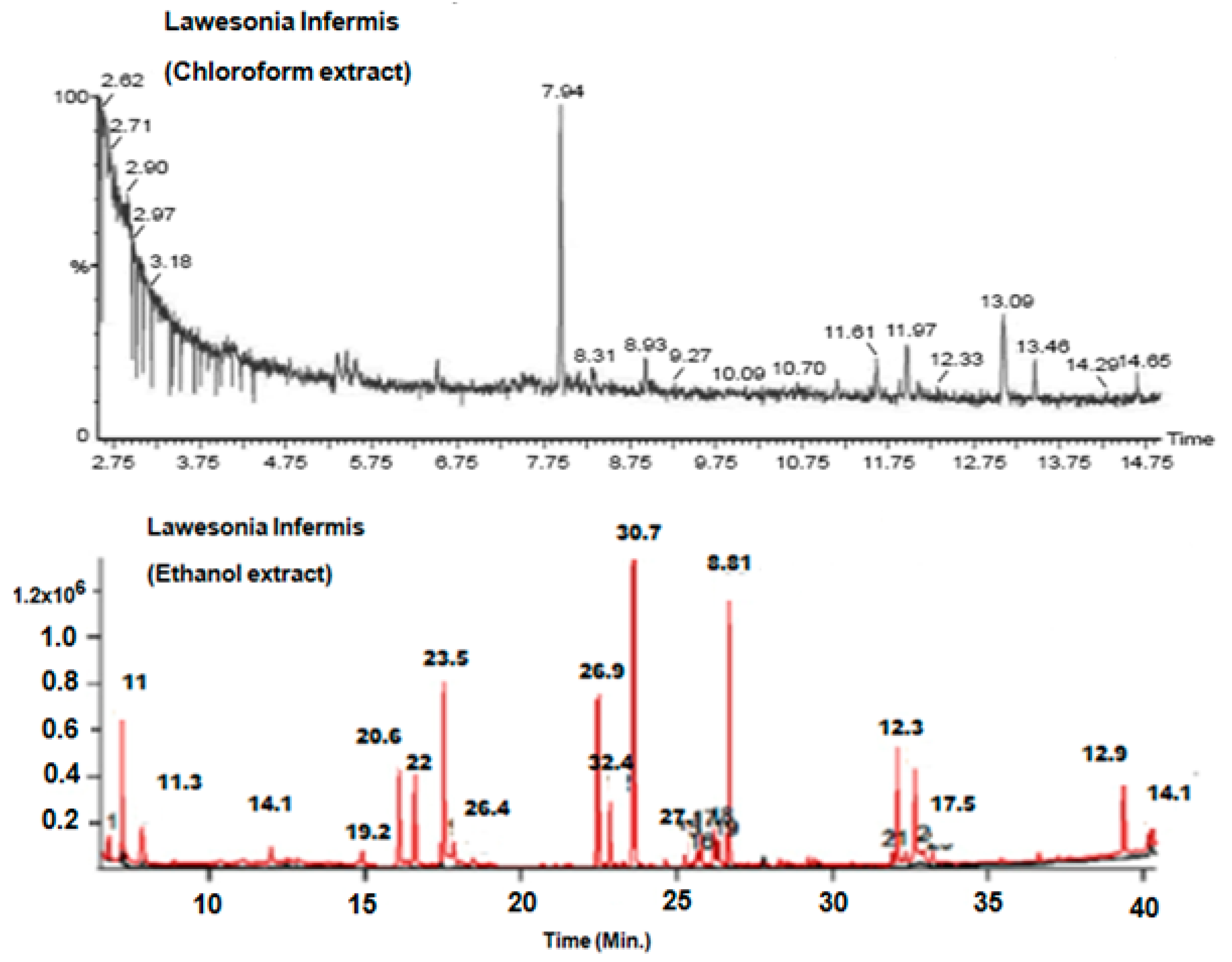
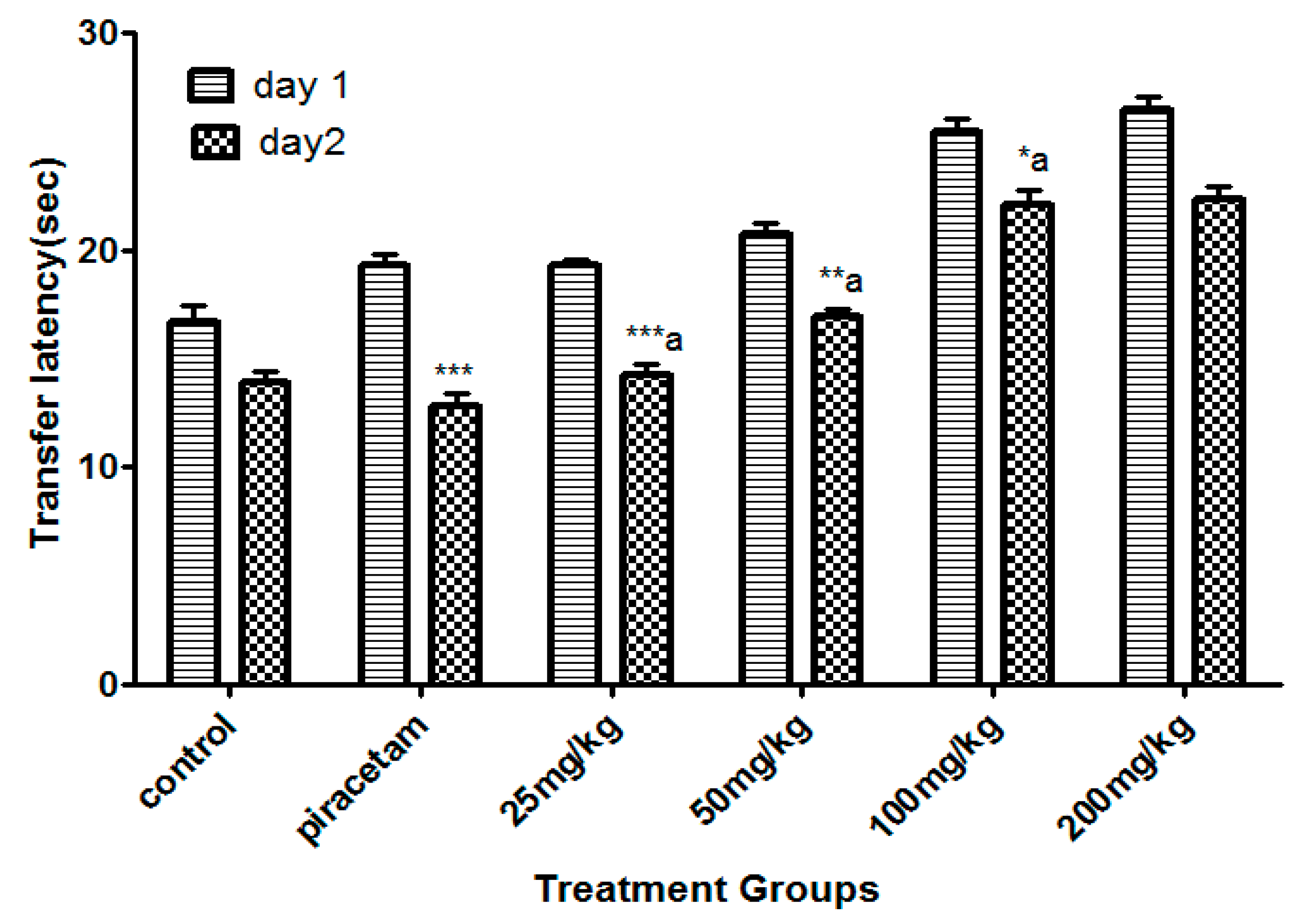
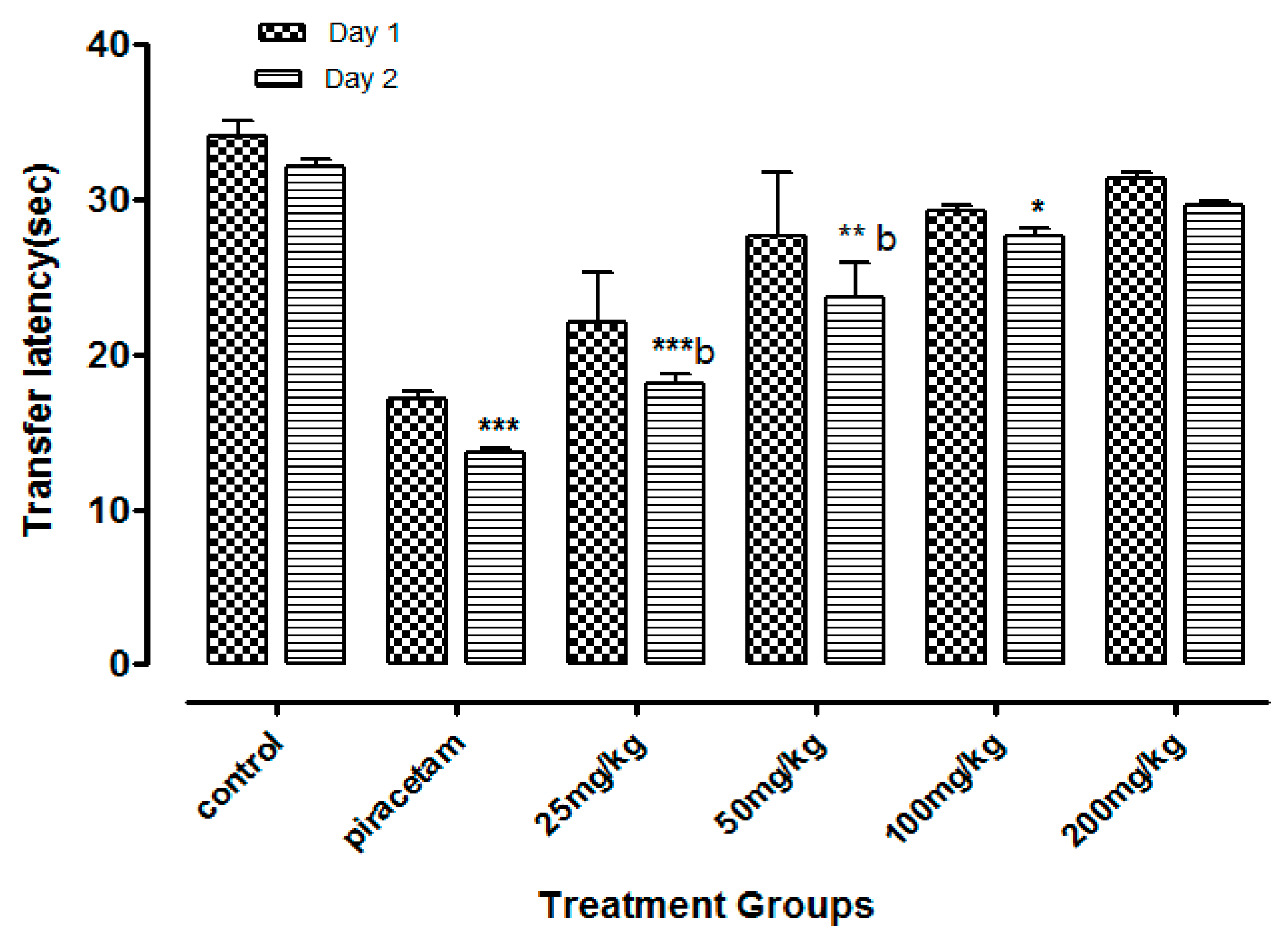


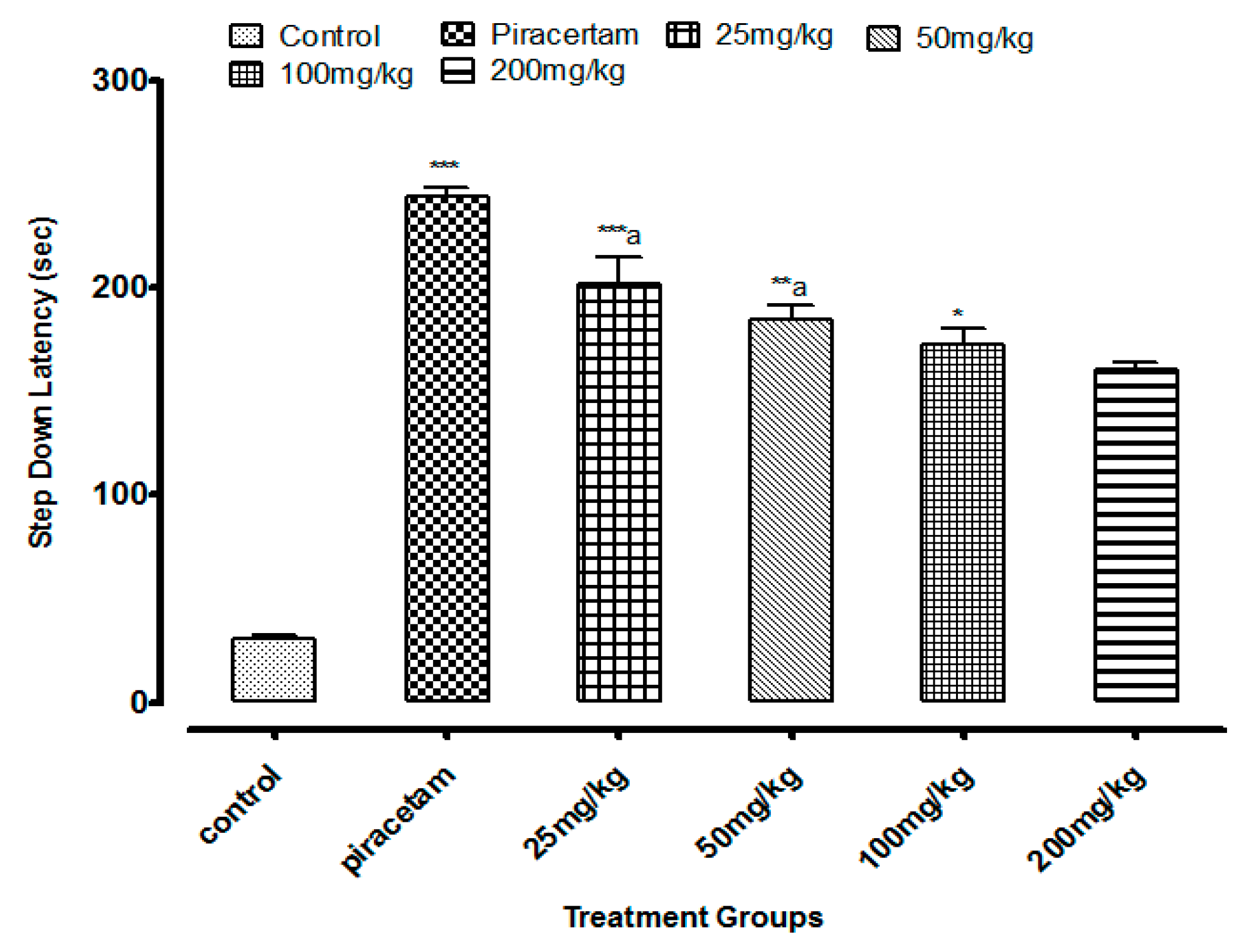
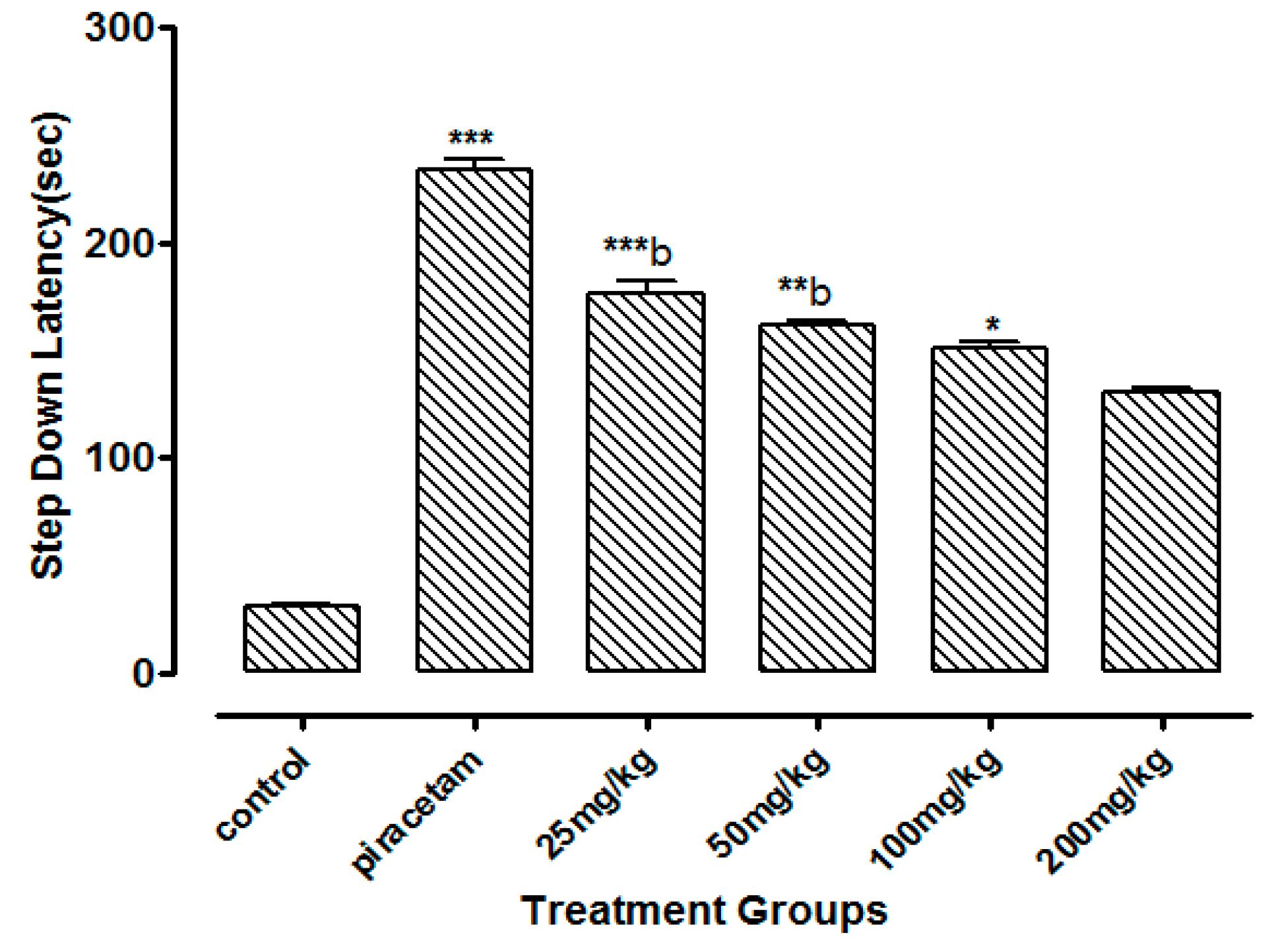
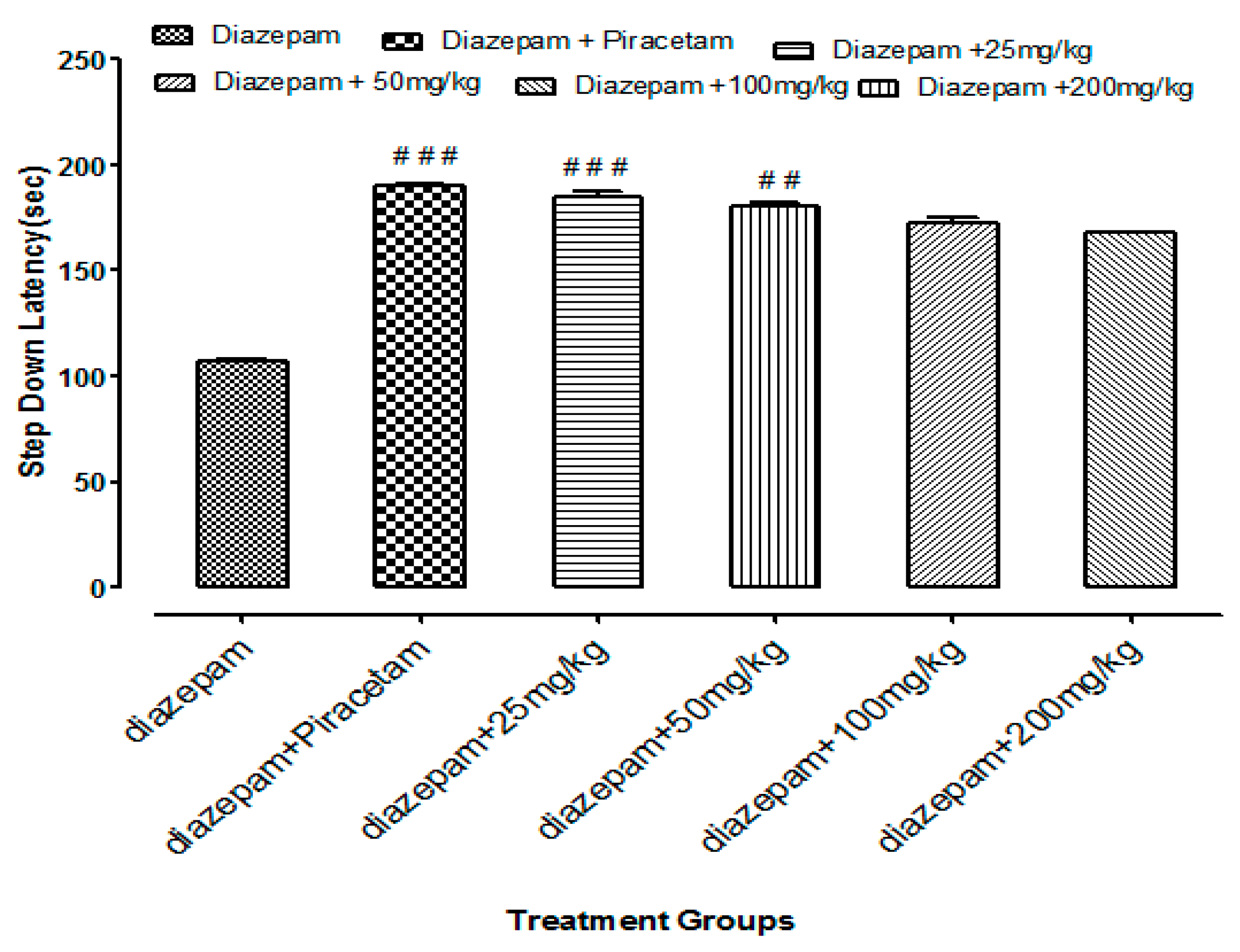

| Serial. No. | Ret. Time (min) | Name of Compound | Molecular Formula | Molecular Weight | Peak Area (%) |
|---|---|---|---|---|---|
| 1 | 4.61 | isoxazolidine, 5-hexyl-, (+) | C9H19NO | 157 | 0.47 |
| 2 | 4.79 | 1,2,4-butanetriol, trinitrate | C4H7N3O9 | 241 | 0.47 |
| 3 | 4.91 | N-ethyl-N’-nitroguanidine | C3H8N4O2 | 132 | 0.47 |
| 4 | 7.94 | phenol, 2,6-bis(1,1-dimethylethyl)-4-methyl-, Methylcarbamate | C17H27NO2 | 277 | 2.37 |
| 5 | 8.31 | 1,3-dimethyl-3-ethyl, 2,5-Pyrrolidinedione | C8H13NO2 | 155 | 0.16 |
| 6 | 8.93 | 2-Piperidinone, N-[4-bromo-n-butyl] | C9H16BrNO | 233 | 0.16 |
| 7 | 11.16 | 3-hexadecyloxycarbonyl-5-(2-hydroxyethyl)-4-methylimidazolium ion | C24H45N2O3 | 409 | 0.16 |
| 8 | 11.97 | 2-(3-Oxo-3-phenylpropyl)-3,5,6-trimethylpyrazine | C16H18N2O | 254 | 0.47 |
| 9 | 13.09 | pyridine-3-carboxamide, 4-dimethylamino-N-(2,4-difluorophenyl) | C14H13F2N3O | 277 | 1.11 |
| 10 | 14.96 | phytol | C20H40O | 296 | 84.97 |
| 11 | 19.82 | pseudoephedrine, (+) | C10H15NO | 165 | 2.06 |
| 12 | 20.85 | aspidofractinine-3-methanol, (2à, 3á, 5à) | C20H26N2O | 310 | 7.12 |
| S. No | Ret. Time (min) | Name of Compound | Molecular Formula | Peak Area (%) |
|---|---|---|---|---|
| 1 | 11 | 3,7,11,15-Tetramethyl-2-hexadecen-1-old | C20H40O | 13.51 |
| 2 | 11.3 | E-2-Tetradecen-1-ol | C14H28O | 7.73 |
| 3 | 14.1 | 2-Tridecen-1-ol, (E)- | C13H26O | 6.26 |
| 4 | 19.2 | Phytol | C20H40O | 39.1 |
| 5 | 20.6 | 1-Eicosanol | C20H42O | 2.75 |
| 6 | 22 | Z,Z-2,5-Pentadecadien-1-old | C15H28O | 1.72 |
| 7 | 23.5 | 3-Hexadecyloxycarbonyl-5-(2-hydroxyethyl)-4-methylimidazolium ion | C24H45N2O3 | 1.42 |
| 8 | 26.4 | Squalene | C30H50 | 2.42 |
| 9 | 26.9 | 6,9,12-Octadecatrienoic acid, phenylmethyl ester, (Z,Z,Z)- | C25H36O2 | 4.38 |
| 11 | 32.4 | 1b,5,5,6a-Tetramethyl-octahydro-1-oxa-cyclopropa[a]inden-6-o | C13H20O2 | 3.53 |
| 12 | 30.7 | Benzenemethanol, 2-(2-aminopropoxy)-3-methyl- | C11H17NO2 | 2.02 |
| 13 | 27.1 | 9-Oxabicyclo[3.3.1]nonan-2-one, 6-hydroxy- | C8H12O3 | 2.14 |
| 14 | 8.81 | Pentanal | C5H10O | 4.73 |
| 15 | 12.3 | Benzeneethanamine, 2-fluoro-á,3-dihydroxy-N-methyl- | C9H12FNO2 | 2.59 |
| 16 | 17.5 | 2-Aminononadecane | C19H41N | 1.14 |
| 17 | 12.9 | Cyclopenta[c]furo[3′,2′:4,5]furo[2,3-h][1]benzopyran-11(1H)-one, 2,3,6a,9a-tetrahydro-1,3-dihydroxy-4-methoxy- | C17H14O7 | 2.23 |
| Groups | Treatment | Dose | SOD (µg/mg) | GSH (nM/mg of protein) | CAT (µg/mg) |
|---|---|---|---|---|---|
| I. | Control | 5% CMC | 1.34 ± 0.009 | 1.27 ± 0.005 | 1.58 ± 0.003 |
| II. | Piracetam | 400 mg/kg, p.o. | 2.47 ± 0.026 *** (↑ 88.6%) | 3.05 ± 0.01 *** (↑ 90%) | 2.87 ± 0.016 *** (↑ 93%) |
| VII. | Diazepam | 1 mg/kg, i.p. | 0.28 ± 0.009 | 0.28 ± 0.008 | 0.19 ± 0.009 |
| III. | Li.Et | 25 mg/kg, p.o. | 2.61 ± 0.059 *** (↑ 89.2%) | 2.75 ± 0.018 *** (↑ 87%) | 2.71 ± 0.049 *** (↑ 91%) |
| IV. | Li.Et | 50 mg/kg, p.o. | 1.13 ± 0.006 ** (↑ 75.2%) | 1.67 ± 0.019 ** (↑ 83%) | 1.94 ± 0.004 ** (↑ 89%) |
| IX. | Li.Et + Diazepam | 25 mg/kg, p.o. +1 mg/kg, i.p. | 1.267 ± 0.019 * (↑ 73%) | 1.98 ± 0.034 * (↑ 88%) | 1.43 ± 0.029 * (↑ 86%) |
| X. | Li.Et +Diazepam | 50 mg/kg, p.o. +1 mg/kg, i.p. | 1.03 ± 0.015 (↑ 71%) | 1.58 ± 0.026 (↑ 85%) | 1.26 ± 0.025 (↑ 83%) |
© 2019 by the authors. Licensee MDPI, Basel, Switzerland. This article is an open access article distributed under the terms and conditions of the Creative Commons Attribution (CC BY) license (http://creativecommons.org/licenses/by/4.0/).
Share and Cite
Mir, N.T.; Saleem, U.; Anwar, F.; Ahmad, B.; Ullah, I.; Hira, S.; Ismail, T.; Ali, T.; Ayaz, M. Lawsonia Inermis Markedly Improves Cognitive Functions in Animal Models and Modulate Oxidative Stress Markers in the Brain. Medicina 2019, 55, 192. https://doi.org/10.3390/medicina55050192
Mir NT, Saleem U, Anwar F, Ahmad B, Ullah I, Hira S, Ismail T, Ali T, Ayaz M. Lawsonia Inermis Markedly Improves Cognitive Functions in Animal Models and Modulate Oxidative Stress Markers in the Brain. Medicina. 2019; 55(5):192. https://doi.org/10.3390/medicina55050192
Chicago/Turabian StyleMir, Numra Tariq, Uzma Saleem, Fareeha Anwar, Bashir Ahmad, Izhar Ullah, Sundas Hira, Tariq Ismail, Tahir Ali, and Muhammad Ayaz. 2019. "Lawsonia Inermis Markedly Improves Cognitive Functions in Animal Models and Modulate Oxidative Stress Markers in the Brain" Medicina 55, no. 5: 192. https://doi.org/10.3390/medicina55050192
APA StyleMir, N. T., Saleem, U., Anwar, F., Ahmad, B., Ullah, I., Hira, S., Ismail, T., Ali, T., & Ayaz, M. (2019). Lawsonia Inermis Markedly Improves Cognitive Functions in Animal Models and Modulate Oxidative Stress Markers in the Brain. Medicina, 55(5), 192. https://doi.org/10.3390/medicina55050192





